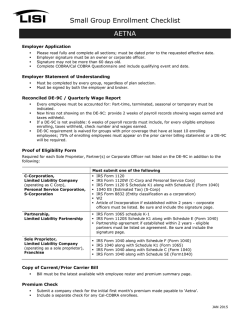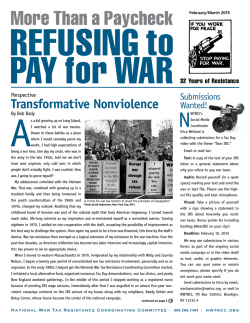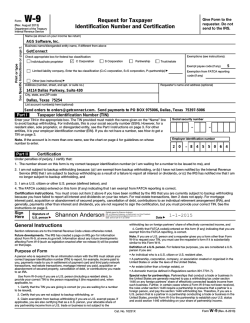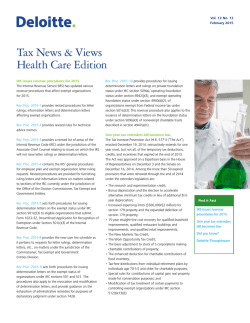
QUASI-VERGER SHARI\G COSTS WITH LIKE
• The cost savings from shared services can help struggling organizations continue to assist their communities and help strong organizations expand and serve even more people. QUASI-VERGER SHARI\G COSTS WITH LIKE-VI\D D ORGA\IZATIO\S ALEXANDER L. REID "Do more with less." This is the unstated mantra of every nonprofit organization manager. One of the best ways to put paid to this principle is to share costs with a like minded-organization through a partial consolidation or "quasi-merger:' A full merger is often not desirable for a variety of reasons—especially when it means the end of an organization's existence. In that context, donor relations become challenging because no one wants to fund an organization that is going out of business. Moreover, gaining management approval for a full merger is complicated by the difficulty in finding an appropriate role for the members of each organization's governing body. No one wants to vote him- or herself out of a job. Yet the potential cost savings and other benefits of consolidation can be tantalizing. It is not only inefficient but also expensive for organizations striving to accomplish similar goals to duplicate the resources necessary to operate their programs — finance, maintenance, records, information technology, human resources, etc. While it is sometimes possible to outsource these services to a for-profit service provider, outsourcing may not deliver the same degree of savings as a ALEXANDER L. REID is of Counsel in the Washington, DC office of Morgan, Lewis ear Bockius LLP. 26 TAXATION OF EXEMPTS ■ HJANUARY/FEBRUARY 2015 merger because the service provider absorbs some of the economic benefit through fees. Also, many nonprofit business models require specialized support services, which may not mesh easily with the services offered by forprofit providers. For that reason, organizations that share a common mission will sometimes band together to eliminate costs by sharing their resources through a joint operating or cost-sharing agreement. If planned properly, the savings that result from such arrangements can enable both organizations to deliver more program services than they could on their own, and thereby better accomplish their charitable purposes. It can be a win-win for all concerned. Practical considerations There are numerous practical considerations to bear in mind before undertaking a partial consolidation. How will consolidation affect employee retention? Will some employees be relocated? If so, which company should be the employer? What are the differences between each organization's compensation structure and other benefits? Identifying key employees and analyzing how they will be affected can be critical to the decision. Managers should consider how the consolidation will affect employees' housing, cost of living, commute, and access to education and health care. If some employees do leave, how will the consolidation affect the combined enterprises ability to attract talented employees? Another category of practical considerations involves the physical space and needs of each organization. Is there sufficient office space to accommodate additional employees? How expensive and feasible is it to expand? Can the information technology infrastructure and other utilities handle a greater load? If there is real estate that will no longer be needed after the consolidation, how difficult or costly will it be to dispose of the property? Tax considerations Beyond practical considerations, there are also tax considerations that must be taken into account. The basic issue is this: when one nonprofit organization provides services to another nonprofit organization in exchange for a cost reimbursement or other fee, is the service provider subject to unrelated business income tax as a result of the payment? The answer, like the answer to all interesting tax questions is: "it depends:' Organizations qualify for tax-exempt status under Section 501(c)(3) by virtue of the fact that they serve charitable, educational, religious, scientific, or other recognized exempt purposes. An otherwise tax-exempt organization is nevertheless taxable on income earned from its regularly carried on business activities that are not substantially related to its exempt purposes. The analysis of whether income from services provided to another nonprofit organization is subject to tax generally boils down to a question of whether the services are or are not "related" to accomplishing the organizations exempt purpose. The tax law defines "related" in a technical way, and this is where the analysis can get tricky. A regularly carried on business activity is "related"—and therefore not subject to tax—if the activity contributes importantly to the accomplishment of the organizations exempt purpose.' In other words, the business activity must have a substantial causal connection with the achievement of an organizations exempt purpose. The activity of providing services to another organization may or may not bear a substantial causal connection to the accomplishment of the organization's exempt purpose, depending on the nature of the services provided and the exempt purposes of each organization. QUASI-MERGER In general, the more similar the organizations' purposes are, the more likely the services will qualify as "related:' This is because an activity that contributes importantly to the accomplishment of one organization's exempt purposes is also likely to contribute importantly to the accomplishment of another organization's exempt purposes if the two organizations have similar exempt purposes. Confusion may arise, however, because the concept of "causation" is not intuitive. Moreover, the standard for whether an entity is tax-exempt under Section 501(c)(3) is different from—and higher than—the standard for an activity to qualify as "related" under Section 513. To qualify for Section 501(c)(3) status, an organization must engage primarily in tax-exempt activities (charitable, educational, religious, scientific, etc.). The organization's primary activities must directly further its tax-exempt purposes.2 To do that, the activity must itself be charitable, to enable the organization to qualify for exemption. By contrast, for a regularly carried-on trade or business activity to qualify as "related:' and therefore not subject to unrelated business income tax, the activity need only bear a substantial causal relationship to accomplishing a tax-exempt purpose. The activity need not itself be charitable to qualify as related; rather, the activity may indirectly further the organization's tax-exempt purposes as long as there is a substantial causal connection. When these two standards are conflated, however, and the higher standard for exemption is used to evaluate cost-sharing agreements, the payments from one organization to the other may appear to be unrelated business income. This is erroneous. The Service's position The IRS has long recognized that an organization may accomplish its exempt purposes indirectly by providing services to an organization with a similar mission. For example, in a 1988 general coun1 Under Reg. 1.513-1(d)(2), a trade or business is related for these purposes only if the conduct of the activity "has causal relationship to the achievement of exempt purposes (other than through the production of income)...." It is "substantially related ... only if the causal relationship is a substantial one." Thus, the activity must substantially cause the accomplishment of the exempt purposes. 2 Under Reg. 1.501(c)(3)-1(c)(1), an organization will be treated as "operated exclusively" for exempt purposes "only if it engages primarily in activities which accomplish one or more of such exempt purposes specified in section 501(c)(3).") The activity itself must directly accomplish the exempt purposes. JANUARY/FEBRUARY 2015 ■ TAXATION OF EXEMPTS sel memorandum, a performing arts organization was found to accomplish its mission both by putting on its own theatrical productions and by providing services to other performing arts organizations. These services included box office personnel, doormen, ushers, ticket takers, supervisors, security guards, stage crew, teamsters, wardrobe personnel, maintenance personnel, house managers, bartenders, and sales personnel.' The IRS observed that the "commercial nature" of the services provided is irrelevant to the analysis. It is not necessary, for example, that otherwise commercial services be provided at a discount to market rates. All that matters is whether or not the services bear a substantial causal connection to accomplishing the organizations exempt purpose. This is evident from the fact that the organization was subject to tax on services provided in connection with events that bore no relationship to the performing arts, like wedding receptions, private parties, business meetings, and similar functions. In other words, the same services may receive different tax treatment depending on the purpose they help to achieve. The memorandum concludes, quite reasonably, as follows: "We have found no appropriate basis for distinguishing between [the organization's] own productions and those of the third party lessees. Both activities are designed to promote the performing arts in the community."4 Thus, for a quasi-merger arrangement to be exempt from tax: (1) the merger partner must serve a sufficiently similar exempt purpose that each organization accomplishes its own mission by providing services to the other and (2) the services provided in connection with the arrangement must be "substantially" related, meaning that they should satisfy the "but for" test such that the organization could not accomplish its exempt purpose "but for" the services in question. If both factors are present, the GCM 39715, 04/11/88. /d. 5 Ltr. Rul. 200832027. 6 Id. 7 Ltr, Rul. 9012045. 8 Ltr. Rul. 200216037. 9 Ltr. Rul, 9637051. 18 Ltr. Rul. 8545006. " See Ltr. Rul. 8415048, Ltr. Rul. 8415047, Ltr. Rul. 8415046, and Ltr. Rul. 8327086. 12 Ltr. Rul. 8327086. See also Ltr. Rul. 8230061, in which the IRS found that the sharing of management services did not give rise to unrelated business income tax because such activity "contributes importantly to the efficient operation of the hospital and its related organizations." 3 4 28 TAXATION OF EXEMPTS ■ JANUARY/FEBRUARY 2015 income received by one organization for providing services to the other should be exempt from tax. The IRS has recently ruled that an exempt organization was subject to tax on income from providing administrative services to other nonprofit organizations.' This ruling, however, should not be misinterpreted to stand for the proposition that administrative services are somehow "inherently" taxable and can never be related to an organization's exempt purpose. The ruling involves an organization whose purpose is to make grants to charities in a certain geographic region. Beyond grant-making, the organization's activities also included the sale of grant management and administrative services to other organizations for a fee. The IRS reasoned that the organization's sale of administrative services did not contribute importantly to the accomplishment of its tax-exempt purpose and was therefore unrelated. The IRS found that the causal connection between providing administrative services for a fee and the increased funding of charitable activities in a particular geographic region was too tenuous to pass the "substantial causal connection" test. The IRS also found that the sale of administrative services for a fee to organizations with which the organization did not share a charitable purpose exceeded the size and extent necessary to achieve the organization's tax-exempt purpose.' It is important to understand that the ruling does not stand for the proposition that administrative services by their nature cannot contribute importantly to the accomplishment of any organization's tax-exempt purposes. Rather, the ruling simply stands for the proposition that administrative services are unrelated when they are provided to organizations whose mission is insufficiently similar to that of the service provider. Purely administrative services can meet the relatedness test if they materially assist an organization to deliver its program services. The centralization and sharing of administrative services among organizations that share a related charitable purpose may contribute importantly to the accomplishment of each organization's tax-exempt purposes by reducing costs, thereby improving each organization's ability to deliver program services and increasing each organization's efficiency and effectiveness. QUASI-MERGER There is no "per se" rule that administrative services are always unrelated because they are "too commerciar On the contrary, the IRS has on numerous occasions found that such services do in fact contribute importantly to the accomplishment of an organization's mission. For example, the IRS ruled that the sharing of administrative and professional services between two organizations, X and Y, served to further each organization's exempt purposes and is therefore substantially related. The ruling explains: Since both X and Y's exemption are based at least partially on the same charitable and educational activity, the provision of support services by X to Yin furtherance of that activity would serve to further both X and Y's exempt purpose. Thus, this activity is related to the exempt purposes of both X and Y. Similarly, the provision of certain administrative and professional services under the "Cost Reimbursement Agreement" are deemed to be related to the exempt function of X. Any reimbursement would be considered income from an activity related to the exempt purposes of X.7 In another example, the IRS ruled that an organization's receipt of fees for providing "accounting': "administrative' and other services to organizations with a shared exempt purpose was not income from an unrelated trade or business under Section 513 because such activities "promote section 501(c)(3) purposes" and are therefore substantially related for purposes of determining an organization's unrelated business income.' In other rulings, the IRS has found that the provision of administrative services pursuant to cost-sharing arrangements among entities with a shared exempt purpose does not give rise to unrelated business income because such arrangements substantially contribute to the accomplishment of the organizations' tax-exempt purposes. For example, the IRS ruled: Because ... the sharing of personnel, services, facilities and expenses by and between M and N permit[s] them to carry out their respective tax-exempt operations, these activities are related to their tax-exempt status. Accordingly, we conclude that such transfers will not be unrelated business QUASI-MERGER activity. And they will not give rise to unrelated business taxable income under section 511 through 514.9 In approving the arrangement between M and N, the IRS ruled that reimbursement for several types of shared services would not be considered to be unrelated business taxable income. Specifically included among them were "accounting and clerical services." Similarly, in a 1985 ruling, the IRS held that a resource-sharing arrangement involving "clerical" and "administrative services" among organizations with a common purpose did not constitute unrelated business taxable income." In other instances, the IRS has determined that administrative services do not give rise to unrelated business income tax because they promote economy and efficiency and therefore contribute importantly to the accomplishment of an organization's tax-exempt purposes. For example, several rulings involved organizations that shared a common purpose and that achieved "economy and efficiency of operation" by sharing a variety of services, including "clerical support" services." The IRS held that the sharing of services did not give rise to unrelated business income tax because "the exempt purposes of the organizations are being furthered:'12 None of these rulings is binding as precedent, either on the IRS or on taxpayers. It should be clear, however, that there is no "per se" rule that somehow prohibits administrative services from qualifying as related activities. When one nonprofit provides services to another in exchange for a reimbursement or fee, is the provider subject to UBIT as a result of the payment? Conclusion Quasi merger can be a useful tool or a path through the wilderness, particularly for organizations that are having a hard time making ends meet. The cost savings from shared services can help struggling organizations survive and continue to assist the communities they serve with needed programs. Partial consolidation can also help strong organizations expand and serve even more. In either case, finding the right partner is key. Organizations considering partial consolidation should be sure to consult their tax advisor early on in the process to make sure they plan appropriately. ■ JANUARY/FEBRUARY 2015 . TAXATION OF EXEMPTS 29
© Copyright 2025








